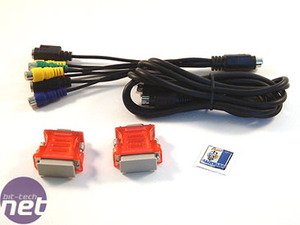The box includes a 6-pin PCI-Express power adapter for those who don't have one included on their power supply. On the subject of power - the power requirements are the same as the reference design and it's recommended that you have a minimum 350W PSU for single card operation and 500W for a pair in SLI.

 There's also two DVI-to-VGA adapters, allowing you to connect two analogue monitors to the card. As the card has a VIVO port, there are several output options for the user - RGB in, S-Video in and out, and Component In/Out connections along with Component extension cable too.
There's also two DVI-to-VGA adapters, allowing you to connect two analogue monitors to the card. As the card has a VIVO port, there are several output options for the user - RGB in, S-Video in and out, and Component In/Out connections along with Component extension cable too.
In the light of some recent feedback from our forum members, we have decided to change the way that we display our results. Rather than focusing on reporting the minimum and average frame rates for every configuration, we have decided to move the focus to resolution and settings. Thus, we are displaying our "Best Playable" resolutions and settings in a table that should be easier to understand than our previous implementation. If you take the logic that the higher the resolution and in game details, the faster the video card, you will not go far wrong.
In situations where we find that two competing video cards run at the same settings, we will bring the frame rates in to the discussion of our game play experiences with each particular video card.
Video Cards:


How We Tested:
Please be aware that the way we test our video cards is not a like-for-like comparison, and it is not meant to be. We decided to concentrate on finding the "Best Playable" settings - this means that we're finding the best possible gaming experience delivered on each different configuration. There are no time demos used in our evaluations - we're focusing on the real-world gaming experience, which is, ultimately what should determine your next graphics card's purchase.In the light of some recent feedback from our forum members, we have decided to change the way that we display our results. Rather than focusing on reporting the minimum and average frame rates for every configuration, we have decided to move the focus to resolution and settings. Thus, we are displaying our "Best Playable" resolutions and settings in a table that should be easier to understand than our previous implementation. If you take the logic that the higher the resolution and in game details, the faster the video card, you will not go far wrong.
In situations where we find that two competing video cards run at the same settings, we will bring the frame rates in to the discussion of our game play experiences with each particular video card.
System Setup
AMD Athlon 64 FX-57 (operating at 2800MHz - 14x200); DFI LANPARTY nF4 SLI-DR (NVIDIA NForce4 SLI); 2 x 512MB OCZ PC5000 Platinum Series (operating in dual channel with 2.0-2-2-10 timings); Western Digital 200GB Caviar SATA 150 Hard disk drive; OCZ PowerStream 520W Power Supply; Windows XP Professional Service Pack 2; DirectX 9.0c; NVIDIA NForce4 Standalone chipset drivers, version 6.53.Video Cards:
- 1 x Gainward PowerPack! Ultra/3500PCX Golden Sample - GeForce 7800 GTX 256MB - operating at its default clock speeds of 470/1300MHz using Forceware 77.76, available on NZone.
- 1 x NVIDIA Reference GeForce 7800 GTX 256MB - operating at its default clock speeds of 430/1200MHz using Forceware 77.76.
- 1 x HIS Radeon X850 XT PE 256MB - operating at its default clock speeds of 540/1180MHz using Catalyst 5.7 WHQL with Catalyst Control Center.
- 2 x XFX GeForce 6800 GT - operating at clock speeds of 350/1000MHz in SLI mode using Forceware version 77.76.

MSI MPG Velox 100R Chassis Review
October 14 2021 | 15:04






Want to comment? Please log in.